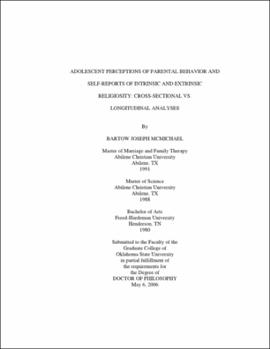| dc.contributor.advisor | Henry, Carolyn S. | |
| dc.contributor.author | McMichael, Bartow Joseph | |
| dc.date.accessioned | 2013-12-10T18:04:20Z | |
| dc.date.available | 2013-12-10T18:04:20Z | |
| dc.date.issued | 2006-05 | |
| dc.identifier.uri | https://hdl.handle.net/11244/7708 | |
| dc.description.abstract | Scope and Method of Study: The purpose of the study was to examine cross-sectional and longitudinal models of how selected demographic and perception of parental behaviors related to variation in adolescent intrinsic and extrinsic religiosity during the early and later years of high school. The data for this study were part of a larger longitudinal study of adolescents and families collected in three non-metropolitan communities located in a South Central state. Longitudinal data were collected at Time 1 when the students were in 9th or 10th grades and at Time 2 when the students were in the 11th or 12th grades. Data were available on 110 students. The self-report data included scales measuring adolescent perceptions of four parental behaviors (support, monitoring, induction, and punitiveness), and adolescent reports of two measures of religiosity (intrinsic and extrinsic). T-tests were run to analyze changes in religiosity over time, ANOVAS were run to analyze differences between boys' and girls' reports of religiosity, and multiple regression was used to analyze whether cross-sectional or longitudinal models combining gender and adolescent perceptions of parental behaviors were better predictors of adolescent religiosity. | |
| dc.description.abstract | Findings and Conclusions: T-tests revealed no significant differences between the Time 1 and the Time 2 reports of either intrinsic or extrinsic religiosity for either boys or girls. The ANOVAs found only one significant difference in reports of religiosity related to gender. At Time 1, boys reported higher extrinsic religiosity than girls. In the bivariate correlations, Time 1 intrinsic religiosity was not related to any of the four parental behaviors, Time 1 extrinsic religiosity was negatively related to mothers' support, Time 2 intrinsic religiosity was positively related to fathers' monitoring, and Time 2 extrinsic religiosity was negatively related to fathers' monitoring and mothers' induction. The multivariate model predicting extrinsic religiosity at Time 1 that combined gender and adolescent perception of mothers' behaviors was the only model found significant in the multiple regressions. Overall, the models predicting extrinsic religiosity were stronger than those predicting intrinsic religiosity. | |
| dc.format | application/pdf | |
| dc.language | en_US | |
| dc.rights | Copyright is held by the author who has granted the Oklahoma State University Library the non-exclusive right to share this material in its institutional repository. Contact Digital Library Services at lib-dls@okstate.edu or 405-744-9161 for the permission policy on the use, reproduction or distribution of this material. | |
| dc.title | Adolescent perceptions of parental behavior and self-reports of intrinsic and extrinsic religiosity: Cross-sectional vs. longitudinal analyses | |
| dc.contributor.committeeMember | Johnson, Christine A. | |
| dc.contributor.committeeMember | Osteen, Sissy R. | |
| dc.contributor.committeeMember | Hirschlein, Beulah M. | |
| osu.filename | Mcmichael_okstate_0664D_1796.pdf | |
| osu.accesstype | Open Access | |
| dc.type.genre | Dissertation | |
| dc.type.material | Text | |
| dc.subject.keywords | adolescence | |
| dc.subject.keywords | religiosity | |
| dc.subject.keywords | symbolic interaction theory | |
| dc.subject.keywords | parental induction | |
| dc.subject.keywords | parental monitoring | |
| dc.subject.keywords | parental support | |
| thesis.degree.discipline | Human Development and Family Science | |
| thesis.degree.grantor | Oklahoma State University | |
